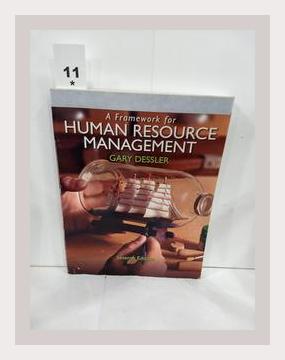Human Resources and Talent ManagementCompensation and Benefits
“A Framework for Human Resource Management” by Gary Dessler is a highly regarded text that provides a comprehensive overview of the essential elements of human resource management (HRM), with a particular focus on compensation and benefits. The book is structured in a logical manner, breaking down HRM into coherent chapters, each dealing with a specific facet of HR functions. This summary aims to provide an intricate look into the key points discussed in the book, providing both theoretical insights and practical actions for HR professionals.
Introduction to Human Resource Management
Gary Dessler begins by laying a foundational understanding of HRM. He defines HRM as the process of acquiring, training, appraising, and compensating employees, and attending to their labor relations, health and safety, and fairness concerns.
Action: Developing a comprehensive HR plan that includes recruitment strategies, training programs, and performance appraisal methods tailored to the organization’s needs.
Job Analysis and Design
Job analysis and design form the bedrock of effective HRM practices. Dessler emphasizes the importance of understanding job roles and responsibilities to develop precise job descriptions and specifications.
Example: An HR manager at a tech company conducting thorough job analyses to determine the skills and competencies required for a software developer role.
Action: Performing regular job analyses to ensure job descriptions are current and accurately reflect the needs of the business.
Recruitment and Selection
Recruitment and selection are pivotal in securing the right talent for the organization. Dessler discusses various recruitment methods, such as internal promotions, employee referrals, and external recruiting.
Example: Utilizing LinkedIn and other professional networks to find qualified candidates for a managerial position.
Action: Implementing a structured interview process that includes behavioral and situational questions to better predict candidates’ future job performance.
Training and Development
Training and development are crucial for employee performance and organizational growth. Dessler explains how effective training programs can bridge the gap between current capabilities and future requirements.
Example: A retail company providing customer service training to improve employee interactions with clients.
Action: Conducting a training needs assessment to identify skill gaps and then developing targeted training sessions to address those needs.
Performance Management and Appraisal
Performance management ensures that employee activities and outcomes are aligned with the organization’s objectives. Dessler outlines different appraisal methods, such as 360-degree feedback, management by objectives (MBO), and rating scales.
Example: A startup using 360-degree feedback to gather performance data from different perspectives.
Action: Establishing a transparent performance appraisal system and providing regular feedback to employees to support continuous improvement.
Compensation and Benefits
Compensation and benefits are critical in retaining and motivating employees. Dessler discusses various compensation strategies including salary surveys, job evaluations, pay scales, and incentive plans.
Example: Implementing a performance-based incentive plan to reward top performers in a sales team.
Action: Conducting market research to ensure competitive compensation packages that attract and retain top talent.
Employee Relations
Effective employee relations involve maintaining a positive employer-employee relationship that contributes to improved morale and productivity. Dessler details conflict resolution strategies and emphasizes open communication channels.
Example: Mediating a conflict between team members to maintain a harmonious workplace environment.
Action: Creating an employee handbook that outlines policies and procedures to ensure clarity and consistency in employee relations.
Health, Safety, and Ethics
Dessler underscores the importance of a safe and healthy working environment, as well as adhering to ethical practices. He explains how OSHA regulations and company ethics policies play a crucial role in workplace safety and integrity.
Example: Implementing strict safety protocols in a manufacturing plant to comply with OSHA standards.
Action: Providing regular ethics training sessions to promote a culture of integrity within the organization.
Strategic HRM and The Future of HR
Strategic HRM aligns the HR function with the broader business strategy to drive long-term success. Dessler elaborates on how technological advancements, globalization, and changing workforce demographics impact HRM.
Example: An international corporation aligning HR strategies with global expansion goals, adjusting for cultural differences.
Action: Leveraging HR analytics to make data-driven decisions that align with the company’s strategic objectives.
Practical Applications and Actions
- Developing an HR Plan:
-
Action: Outline clear and measurable objectives for each HR function, such as recruitment targets and training outcomes.
-
Conducting Job Analyses:
-
Action: Regularly review job roles and engage with employees to update job descriptions and ensure they reflect current responsibilities.
-
Structured Recruitment Process:
-
Action: Use a mix of internal and external recruitment channels and develop a standard interview guide to ensure consistency in candidate evaluation.
-
Implementing Training Programs:
-
Action: Design a comprehensive training calendar that addresses both immediate needs and long-term development goals.
-
Establishing Performance Appraisal Systems:
-
Action: Train managers to give constructive feedback and link performance evaluations to career progression and salary adjustments.
-
Competitive Compensation Packages:
-
Action: Regularly review industry salary benchmarks and adjust compensation packages to maintain competitiveness.
-
Maintaining Positive Employee Relations:
-
Action: Foster an open-door policy and conduct regular employee satisfaction surveys to understand and address employee concerns.
-
Promoting Workplace Safety and Ethics:
-
Action: Develop a safety training program and enforce a zero-tolerance policy for unethical behavior.
-
Aligning HR with Strategic Goals:
- Action: Integrate HR metrics into the broader business performance dashboard and review them regularly to ensure alignment with strategic priorities.
Conclusion
Gary Dessler’s “A Framework for Human Resource Management” provides a detailed roadmap for effectively managing HR functions, with a strong emphasis on compensation and benefits. By combining theoretical frameworks with practical advice, Dessler equips HR professionals with the tools needed to enhance employee performance and drive organizational success. Through regular job analysis, strategic recruitment, continuous training, effective performance management, competitive compensation, positive employee relations, and adherence to safety and ethical standards, organizations can create a workplace environment that not only attracts but retains top talent.
Human Resources and Talent ManagementCompensation and Benefits
